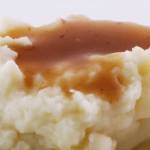CJ’s Cheesy Cheese Bread Recipe
In preparation for a baby shower, I was asked to make a cheese bread. I tried a couple that were in my cookbooks, but neither had the texture or cheesiness that I was looking for. That sent me searching on the web. Again, no joy.
I decided that what I was really looking for was a ciabatta bread variant with a lot of cheesiness added. The recipe below was my second attempt at assembling the elements I wanted. It’s a very cheesy bread, but because of the amount of cheese combined with this not being formed from a sponge, it doesn’t develop the porous texture that is typical of many American versions of this bread type.
I chose the cheeses so that they would give a very cheesy taste without being too oily (a problem with most cheese breads) and without being too foreign (if diners question “gruyere”, just say that it’s basically swiss cheese without the holes…they’ll eat it).
As I wanted an artisanal/rustic quality, I just let the dough spread as it wanted to on the parchment. Feel free to try putting it in a pan…let me know if it cooks all the way through without burning (I’m curious).
Title: CJ’s Cheesy Cheese Bread
Servings: 24
Cooking Time: 20 minutes
Preparation Time: 4 hours
Category: Breads
Rating: 4.5/5 stars
Source: Personal Recipe
—
Ingredients
—
1 pkg Rapid-rise yeast
1½ c water
1½ tsp salt
1 tbsp sugar
2 tsp Olive Oil
3½ c all-purpose flour
3 oz parmasiano reggiano cheese
3 oz gruyere cheese
6 oz extra sharp cheddar cheese
—
Instructions
—
Combine flour, yeast, salt, and sugar in a bowl (not the mixer’s bowl) and whisk together.
Cut 4oz of the cheddar cheese into ¼”-½” cubes. Sprinkle with some of the flour mix to coat (this prevents sticking and helps keep cheese suspended in dough).
Shread the remaining cheddar as well as the gruyere and parm, and combine. Set aside.
Add water (90-100°F) to a mixer’s mixing bowl. On low speed, slowly add the flour mixture about ½-1 cup at a time, allowing about half of the previous addition to be moistened. When the last of the flour is added and a dough ball has formed, add the olive oil and 1/2-2/3 of the shredded cheese mixture. Increase mixer speed to medium or slightly slower to combine the cheese. Reduce speed and add the cheese cubes until more-or-less incorporated into the dough.
Use some olive oil to grease the sides of a bowl about 3x larger than the dough ball. Using quick movements to lessen sticking, remove and hold in your hands the dough ball, pushing in any cheese cubes trying to escape. Move from hand to hand as you form dough into a ball with no exposed cheese, and put it into the greased bowl. Sprinkle a very small amount of olive oil on top of the ball and lightly coat the top of the ball. Loosely place some plastic wrap on top and let rise in a warm (not hot) area until dough is doubled in size (about 1½ hours).
Place a sheet of parchment paper on a piel. Using finger tips, punch down the risen dough inside the bowl. Pull off half the dough and using your hands shape it into a rough cylinder about 6″+ long. Place on the piel. Repeat for the remaining dough, placing it about 3″ from the first loaf. With the remaining shredded cheese, coat the tops of both loaves about evenly and gently press the cheese into the loaves. Try for as even a coating as possible, and try to leave as little cheese as possible on the parchment as it only tends to burn. Let rise until about doubled in size (1-to-1½ hours).
Put a pizza stone in a low position in your oven. Pre-heat oven to 410°F (425°F at altitude). Slide risen dough still on the parchment paper onto the stone. Cook approximately 20 minutes until top is golden and bottom is toasted but not dark.
Remove from oven and put on cooling racks for at least 30 minutes.
—
Notes
—
The dough is very soft and sticky. If you use quick movements to manipulate the dough, very little will stick to your hands or the bowl.
It’s very important that you don’t over-cook this bread as the cheese will acquire a very pronounced and bitter burnt-toast taste.








Leave a Reply